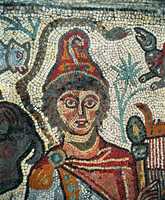
Double Identity
Orpheus as David. Orpheus as Christ?
By Jas´ Elsner
Picture
A splendid mosaic now in the Istanbul Archaeological Museum is said to portray Christ as Orpheus playing his lyre. A similar figure in a synagogue mosaic discovered in Gaza in the 1960s—resembling the traditional form of Orpheus but labeled “David”—may be thought to support this interpretation of Orpheus as Christ. But on closer examination the comparison falters. Allow me to unpack this.
The Istanbul mosaic—or, more appropriately the Jerusalem mosaic, for it was discovered in 1901 northwest of Damascus Gate during the years of Ottoman dominion over Palestine—is one of the most impressive products of late antique mosaic production to survive from the Holy Land. Although Orpheus taming the animals with his lyre is the central panel, it is only a small part of a grand mosaic floor that includes a series of registers, each with panels of figural imagery inset into the complex and delightful decorative framing typical of Roman mosaics.1
Good general introductions to ancient mosaics include R. Ling, Ancient Mosaics (London: British Museum Press, 1998) and K. Dunbabin, Mosaics of the Greek and Roman World (New York: Cambridge Univ. Press, 1999).
http://members.bib-arch.org/publication.asp?PubID=BSBA&Volume=35&Issue=2&ArticleID=8